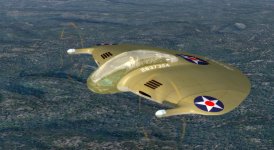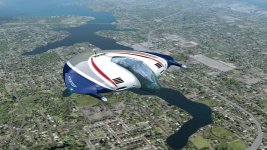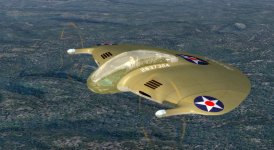The Northrop flying wings (from the N-9M all the way up through the B-2) didn't have tails. Instead, they used split aileron spoilers for yaw control.
Well....it's interesting that you'd bring up the Northrop Flying Wings. In fact, they had their own issues, particularly hunting around the yaw axis in rough air, after turns, etc......and we're not getting into what happened about stall recovery.
It's most notable that these handling "eccentricities" were essentially solved decades later in Northrop-Grumman's B-2 Spirit bomber with it's advanced computer-generated artificial stability system.
The Vought prototypes V-173 (flown) and XF5U (taxied) beyond their odd shaped low aspect ratio wing had vertical and horizontal tail surfaces. ( The idea of the props placed in such a remote location was that they would cancel out the wing tip vortices with their opposing rotation, thus enhancing an already efficient high performance wing platform.)
Judging by pilot reports of the well wrung-out V-173, the plane was a sweet performer. The main issue they suffered from had nothing to do with handling. It was all about critical vibration along the engine/drive shaft/transmission/ propeller system. In the case of the much larger XF5U, the vibration issue was never solved before the government pulled the plug on the project.
So now.....we're looking at a gorgeous rendition of a near-future fantasy plane, essentially a furtherance of Vought's Flying Pancake prototypes........minus the aft control surfaces.
....Hmmmmm....
It has me intrigued, and re-reading Bill's description at his website....there is mention of electronics looking after directional stability by manipulating prop pitch, power, and prop-housing attitude.
This gets us back to your reference of the old Flying Wing prototypes, whose issues were solved in the modern B-2 with it's advanced computer systems generating constant stability in a manner that would be inefficient or impossible under the multi-tasking pilot's control.
As outlandish as the Stingrey model appears, a little reading has left me thinking that the design could be quite feasible with today's technology, providing the development budget was generous enough, and the market was sustain-ably secure enough to attract critical investment.
Bill's "futurist" ideas are always startling, always pleasing, totally optimistic, and yet are always based in relative feasibility. That's what had me going when I first looked at the images....questions about feasibility. But with a little internet exploration, pulling some books off the shelf, I'm happy that Bill has maintained a relative reality, wrapped up in a very exciting set of ideas. (Amazing rendering too!!)
I have no doubt that we'll see aircraft designs like this in the next couple of decades......and when you do.....remember...Bill told you about it here.....first.
















